Anli Ji
Towards Hybrid Embedded Feature Selection and Classification Approach with Slim-TSF
Sep 06, 2024Abstract:Traditional solar flare forecasting approaches have mostly relied on physics-based or data-driven models using solar magnetograms, treating flare predictions as a point-in-time classification problem. This approach has limitations, particularly in capturing the evolving nature of solar activity. Recognizing the limitations of traditional flare forecasting approaches, our research aims to uncover hidden relationships and the evolutionary characteristics of solar flares and their source regions. Our previously proposed Sliding Window Multivariate Time Series Forest (Slim-TSF) has shown the feasibility of usage applied on multivariate time series data. A significant aspect of this study is the comparative analysis of our updated Slim-TSF framework against the original model outcomes. Preliminary findings indicate a notable improvement, with an average increase of 5\% in both the True Skill Statistic (TSS) and Heidke Skill Score (HSS). This enhancement not only underscores the effectiveness of our refined methodology but also suggests that our systematic evaluation and feature selection approach can significantly advance the predictive accuracy of solar flare forecasting models.
Embedding Ordinality to Binary Loss Function for Improving Solar Flare Forecasting
Aug 21, 2024

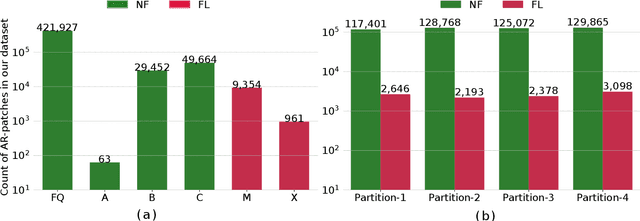

Abstract:In this paper, we propose a novel loss function aimed at optimizing the binary flare prediction problem by embedding the intrinsic ordinal flare characteristics into the binary cross-entropy (BCE) loss function. This modification is intended to provide the model with better guidance based on the ordinal characteristics of the data and improve the overall performance of the models. For our experiments, we employ a ResNet34-based model with transfer learning to predict $\geq$M-class flares by utilizing the shape-based features of magnetograms of active region (AR) patches spanning from $-$90$^{\circ}$ to $+$90$^{\circ}$ of solar longitude as our input data. We use a composite skill score (CSS) as our evaluation metric, which is calculated as the geometric mean of the True Skill Score (TSS) and the Heidke Skill Score (HSS) to rank and compare our models' performance. The primary contributions of this work are as follows: (i) We introduce a novel approach to encode ordinality into a binary loss function showing an application to solar flare prediction, (ii) We enhance solar flare forecasting by enabling flare predictions for each AR across the entire solar disk, without any longitudinal restrictions, and evaluate and compare performance. (iii) Our candidate model, optimized with the proposed loss function, shows an improvement of $\sim$7%, $\sim$4%, and $\sim$3% for AR patches within $\pm$30$^\circ$, $\pm$60$^\circ$, and $\pm$90$^\circ$ of solar longitude, respectively in terms of CSS, when compared with standard BCE. Additionally, we demonstrate the ability to issue flare forecasts for ARs in near-limb regions (regions between $\pm$60$^{\circ}$ to $\pm$90$^{\circ}$) with a CSS=0.34 (TSS=0.50 and HSS=0.23), expanding the scope of AR-based models for solar flare prediction. This advances the reliability of solar flare forecasts, leading to more effective prediction capabilities.
Active Region-based Flare Forecasting with Sliding Window Multivariate Time Series Forest Classifiers
Feb 05, 2024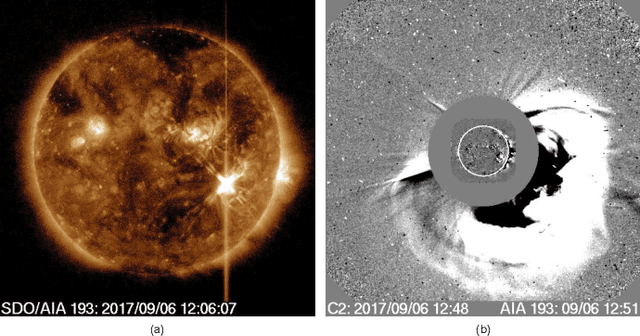
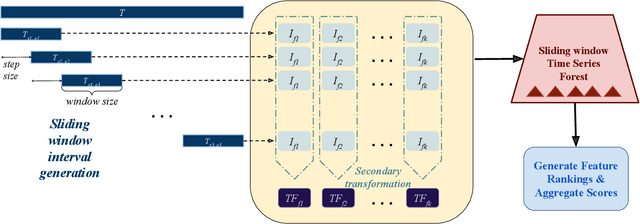
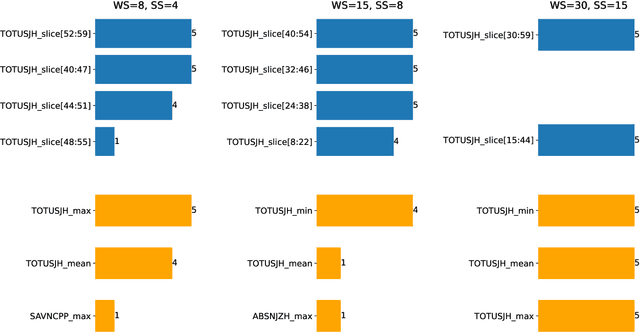

Abstract:Over the past few decades, many applications of physics-based simulations and data-driven techniques (including machine learning and deep learning) have emerged to analyze and predict solar flares. These approaches are pivotal in understanding the dynamics of solar flares, primarily aiming to forecast these events and minimize potential risks they may pose to Earth. Although current methods have made significant progress, there are still limitations to these data-driven approaches. One prominent drawback is the lack of consideration for the temporal evolution characteristics in the active regions from which these flares originate. This oversight hinders the ability of these methods to grasp the relationships between high-dimensional active region features, thereby limiting their usability in operations. This study centers on the development of interpretable classifiers for multivariate time series and the demonstration of a novel feature ranking method with sliding window-based sub-interval ranking. The primary contribution of our work is to bridge the gap between complex, less understandable black-box models used for high-dimensional data and the exploration of relevant sub-intervals from multivariate time series, specifically in the context of solar flare forecasting. Our findings demonstrate that our sliding-window time series forest classifier performs effectively in solar flare prediction (with a True Skill Statistic of over 85\%) while also pinpointing the most crucial features and sub-intervals for a given learning task.
Towards Interpretable Solar Flare Prediction with Attention-based Deep Neural Networks
Sep 08, 2023Abstract:Solar flare prediction is a central problem in space weather forecasting and recent developments in machine learning and deep learning accelerated the adoption of complex models for data-driven solar flare forecasting. In this work, we developed an attention-based deep learning model as an improvement over the standard convolutional neural network (CNN) pipeline to perform full-disk binary flare predictions for the occurrence of $\geq$M1.0-class flares within the next 24 hours. For this task, we collected compressed images created from full-disk line-of-sight (LoS) magnetograms. We used data-augmented oversampling to address the class imbalance issue and used true skill statistic (TSS) and Heidke skill score (HSS) as the evaluation metrics. Furthermore, we interpreted our model by overlaying attention maps on input magnetograms and visualized the important regions focused on by the model that led to the eventual decision. The significant findings of this study are: (i) We successfully implemented an attention-based full-disk flare predictor ready for operational forecasting where the candidate model achieves an average TSS=0.54$\pm$0.03 and HSS=0.37$\pm$0.07. (ii) we demonstrated that our full-disk model can learn conspicuous features corresponding to active regions from full-disk magnetogram images, and (iii) our experimental evaluation suggests that our model can predict near-limb flares with adept skill and the predictions are based on relevant active regions (ARs) or AR characteristics from full-disk magnetograms.
Exploring Deep Learning for Full-disk Solar Flare Prediction with Empirical Insights from Guided Grad-CAM Explanations
Aug 30, 2023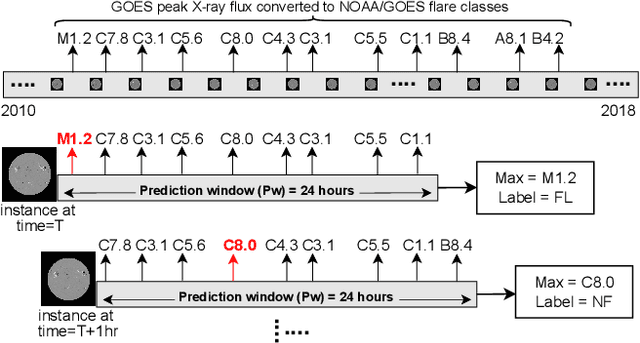
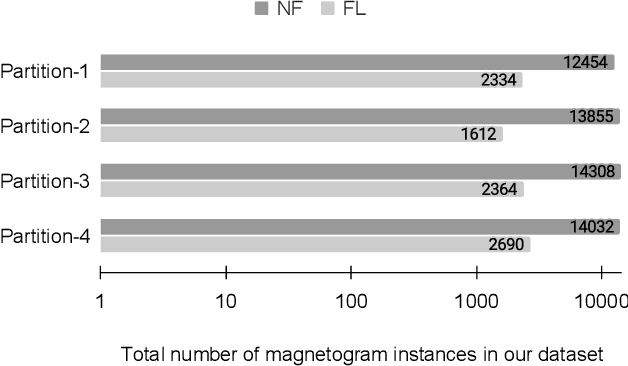
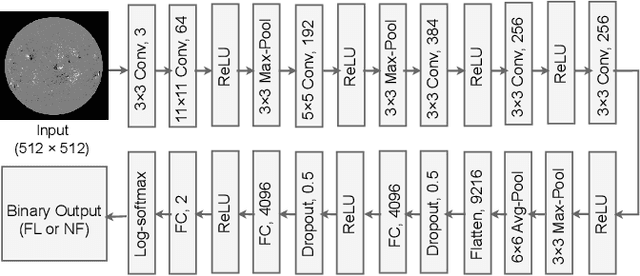
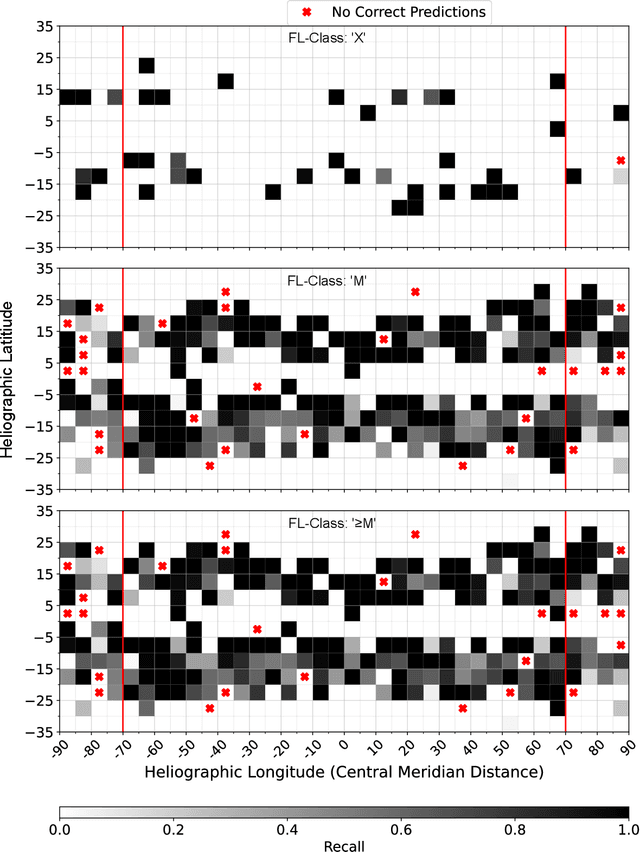
Abstract:This study progresses solar flare prediction research by presenting a full-disk deep-learning model to forecast $\geq$M-class solar flares and evaluating its efficacy on both central (within $\pm$70$^\circ$) and near-limb (beyond $\pm$70$^\circ$) events, showcasing qualitative assessment of post hoc explanations for the model's predictions, and providing empirical findings from human-centered quantitative assessments of these explanations. Our model is trained using hourly full-disk line-of-sight magnetogram images to predict $\geq$M-class solar flares within the subsequent 24-hour prediction window. Additionally, we apply the Guided Gradient-weighted Class Activation Mapping (Guided Grad-CAM) attribution method to interpret our model's predictions and evaluate the explanations. Our analysis unveils that full-disk solar flare predictions correspond with active region characteristics. The following points represent the most important findings of our study: (1) Our deep learning models achieved an average true skill statistic (TSS) of $\sim$0.51 and a Heidke skill score (HSS) of $\sim$0.38, exhibiting skill to predict solar flares where for central locations the average recall is $\sim$0.75 (recall values for X- and M-class are 0.95 and 0.73 respectively) and for the near-limb flares the average recall is $\sim$0.52 (recall values for X- and M-class are 0.74 and 0.50 respectively); (2) qualitative examination of the model's explanations reveals that it discerns and leverages features linked to active regions in both central and near-limb locations within full-disk magnetograms to produce respective predictions. In essence, our models grasp the shape and texture-based properties of flaring active regions, even in proximity to limb areas -- a novel and essential capability with considerable significance for operational forecasting systems.
All-Clear Flare Prediction Using Interval-based Time Series Classifiers
May 03, 2021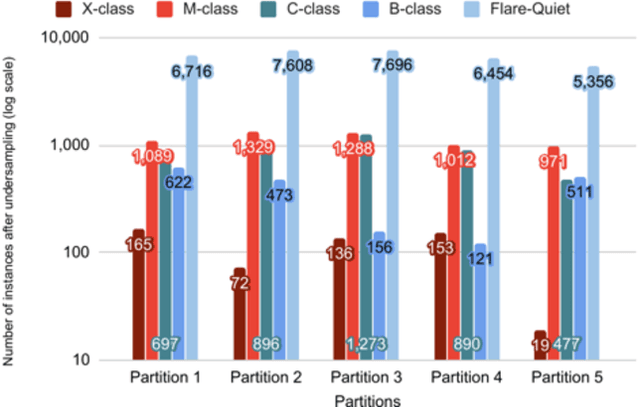
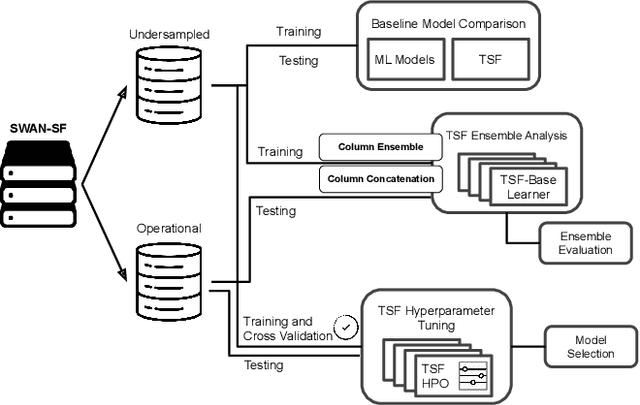
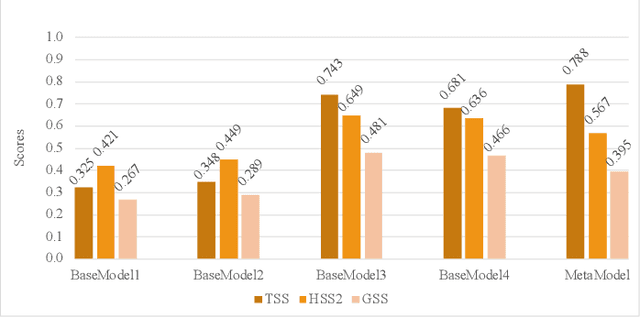
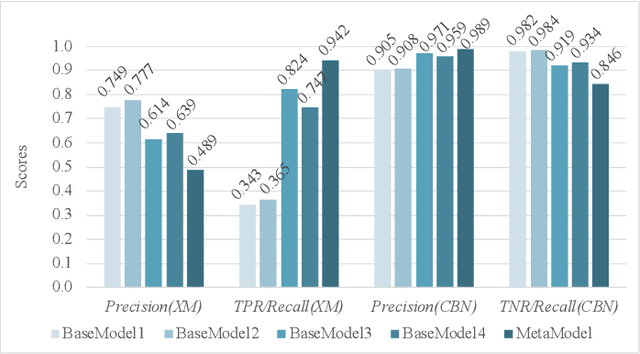
Abstract:An all-clear flare prediction is a type of solar flare forecasting that puts more emphasis on predicting non-flaring instances (often relatively small flares and flare quiet regions) with high precision while still maintaining valuable predictive results. While many flare prediction studies do not address this problem directly, all-clear predictions can be useful in operational context. However, in all-clear predictions, finding the right balance between avoiding false negatives (misses) and reducing the false positives (false alarms) is often challenging. Our study focuses on training and testing a set of interval-based time series classifiers named Time Series Forest (TSF). These classifiers will be used towards building an all-clear flare prediction system by utilizing multivariate time series data. Throughout this paper, we demonstrate our data collection, predictive model building and evaluation processes, and compare our time series classification models with baselines using our benchmark datasets. Our results show that time series classifiers provide better forecasting results in terms of skill scores, precision and recall metrics, and they can be further improved for more precise all-clear forecasts by tuning model hyperparameters.
 Add to Chrome
Add to Chrome Add to Firefox
Add to Firefox Add to Edge
Add to Edge